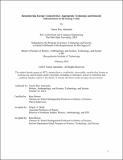Remembering Energic Connectivities: Appropriate Technology and Domestic Infrastructure in the Energy Crisis
Author(s)
Adornetto, Turner Day
DownloadThesis PDF (13.61Mb)
Advisor
Brown, Kate
Terms of use
Metadata
Show full item recordAbstract
The electric grid is a large, complex machine. And yet, it represents but one, narrow framework for energic relations. Visions for just and sustainable futures – for social and ecological repair – should wander further afield. One place they could go is home. In this essay, the Appropriate Technology Small Grants Program, an oft-forgotten chapter of U.S. energy history, shows us how small-scale, place-based inventors transformed homes and neighborhoods into converters and conductors of nearby flows and potentials. At the height of the energy crisis of the 1970s, these inventors pursued a distributed solution to shortage. Along the way, they re-wired the material and conceptual strictures of the modern dwelling and broke into a vast reserve of lowcost, renewable power. Home, they showed, was a workshop to understand and design energic connectivities. But tracing the effects of home-based appropriate technology leads us somewhere else – to the frontiers of energy extraction, where social justice activists proved that small-scale, place-based energy systems could replace unjust mines and dams. What emerged, then, through renewed attention to the possibilities for home and energy, was a powerful counter to the logics of sacrifice at both ends of the energy continuum. Today, as we chart our own response to crisis, it helps to remember how others tried to create solidarities and resist tradeoffs with small-scale, place-based infrastructures. We can, I think, do more with energy.
Date issued
2025-02Department
Massachusetts Institute of Technology. Program in Science, Technology and SocietyPublisher
Massachusetts Institute of Technology